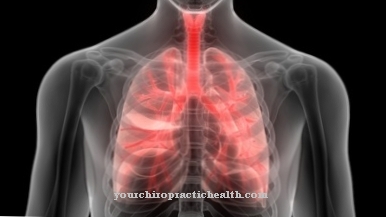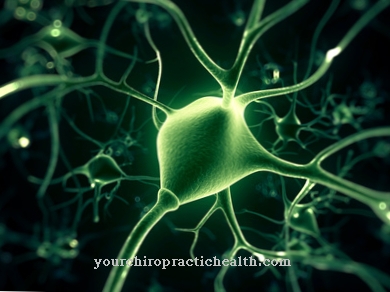The eccrine secretion is a mode of exocrine secretion, as it is pursued, for example, in the salivary glands. The eccrine secretion is released via exocytosis without any cell loss. The over- or underproduction of eccrine secretions indicates various primary diseases.
What is eccrine secretion?

Glands and gland-like cells release their secretions either through endocrine or exocrine secretion. The exocrine glands channel their secretions into a body cavity through ducts. This process can be implemented in three different modes. The three modes of exocrine secretion are holocrine, apocrine and eccrine secretion.
The eccrine secretion is also called merocrine secretion and is the most common mode of secretion in the human body. It occurs, for example, in the salivary glands and in parts of the pancreas. In this mode, the secretion is released through what is known as exocytosis. The terms eccrine and merocrine secretion are rarely distinguished today. When differentiating between the two forms, eccrine secretion could be described in the broadest sense as secretion via channels, transporters or pumps in the apical plasma membrane without secretion granules in the cytoplasm. In contrast, merocrine secretion would be the release of secretion granules without loss of cell material.
Function & task
So-called exocytosis plays a key role in eccrine secretion. During exocytosis, vesicles from the cytosol of a cell fuse with the cell membrane. In this way, the substances stored in the vesicles are released. This process is usually controlled by hormones and thus stimulated by the binding of hormones to receptors on the cell surfaces.
In ectrine glands, the membrane of a secretion granule fuses with an apical plasma membrane. In this way the secretion granules are opened towards the surface. The fused membrane is absorbed back into the cytoplasm via endocytosis and can be used for further granules.
Endocytosis refers to the uptake of substances that are foreign to the cell into a cell, which usually takes place either by invading or constricting parts of the cell membrane. The fact that there are no cell losses with eccrine secretion clearly distinguishes the eccrine mode from the holocrine mode, in which the secreting cells themselves become secretions and thus perish.
The eccrine part of the sweat glands can be cited as an example of eccrine secretion. Each sweat gland consists of numerous gland cells. The sweat secretion is collected in the endoplasmic reticulum of these cells before it migrates into the Golgi apparatus of the cells and is prepared there. Together with the secretion granules, the stored secretion reaches the surface of the cell. The secretion granules and the cell membrane then fuse and open up. During this opening, the secretion is released into the ducts of the respective gland and the person begins to sweat.
In total, the human body has around two to four million eccrine sweat glands. The large sweat glands in the genital and armpit area also secrete in this way. The eccrine secretion of these glands is not only involved in thermoregulation, but also creates the protective acid mantle of the skin and also performs detoxifying functions.
Even the secretion of saliva takes place in the eccrine mode and is controlled by the autonomic nervous system. The saliva protects the oral mucous membrane from drying out, serves to neutralize acids and is involved in the body's own processes of oral hygiene. In the pancreas, only part of the secretion is to be understood as eccrine secretion. The pancreatic secretion mainly fulfills important functions in digestion. In the mammary gland, the eccrine secretion mode also ensures the release of proteins. Accordingly, eccrine secretion fulfills many functions in the human organism.
You can find your medication here
➔ Medication for bad breath and bad breathIllnesses & ailments
The eccrine sweat glands in particular can be responsible for an underproduction or overproduction of secretions. In the case of the sweat glands, the inability to produce eccrine secretion is known as anhidrosis and can cause circulatory problems, as sweat can no longer regulate the temperature. The cause of the phenomenon can be related to the glands themselves or to dysregulation by the nervous system.
The opposite of a lack of sweat secretion is hyperhidrosis. With this very strong eccrine secretion, the glands give off a lot of sweat. Hyperhidrosis is often perceived by those affected as a psychological burden and can be symptomatic of various primary diseases. Oversecretion due to psychological problems can also occur under certain circumstances. Sclerotherapy of the hyperactive eccrine glands can help with this phenomenon.
Clogging of the eccrine glands is just as common as hyperhidrosis. Such blockages can develop into a build-up of secretion, which in the long run can lead to tumors or even abscesses. These tumors are usually benign and are also known as adenomas.
Over- and undersecretion can affect not only the sweat glands but all other eccrine glands as well. In the pancreas in particular, a primary disease of the organ can be the cause of dysregulated secretions. In the case of the salivary glands, a reduced secretion is usually noticeable in a dry mouth and dental diseases. Sometimes there are also swallowing and speech difficulties.
Like all other eccrine glands, the salivary glands themselves are rarely the cause of secretion problems. In most cases, the misdirected eccrine secretion points to an existing primary disease.












.jpg)



.jpg)










.jpg)
